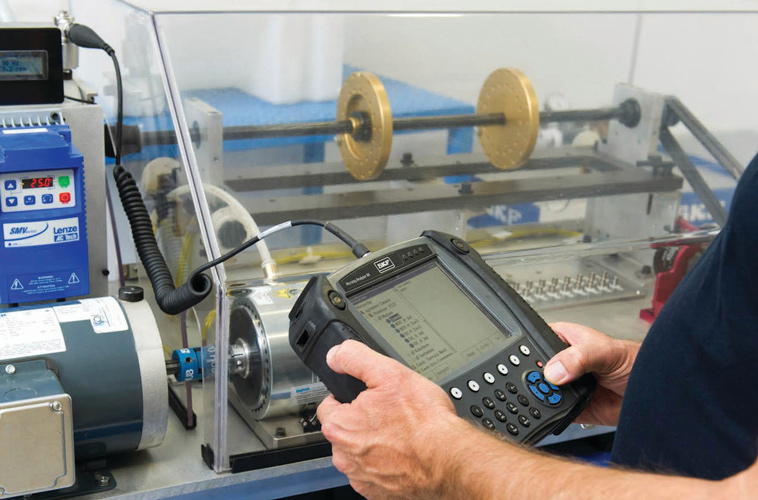How manufacturing might fully embrace the digital age

Looking at established technologies such as condition monitoring and smart, sensor-equipped bearings; Phil Burge, Marketing and Communications Manager at SKF claims that extending the digitalisation here could revolutionise manufacturing.
While digitalisation has made great strides in the consumer market, where music downloads, online shopping and on-demand TV are commonplace, it is now also having a significant impact on manufacturing, with companies like SKF exploiting modern digital technologies to improve its product portfolio and, ultimately, the profitability and operational flexibility of its customers.
The ability to collect and manipulate vast amounts of digital information will be essential for any future manufacturing enterprise. By embracing digitalisation, SKF is effectively adding value to its core business of bearings technology and related services, enabling customers to reap the benefits of digitalisation and boost the performance of their manufacturing assets. With its focus on industrial digitalisation, SKF is seeking further optimisation of costs and efficiencies throughout the value chain, extending its world-class manufacturing capabilities and delivering supply chain integration. Digitalisation will ultimately impact upon all parts of the value chain, from design and manufacturing through to purchasing and maintenance.
An ‘old hand’
SKF has been monitoring equipment remotely for some fifteen years and currently has around one million of its bearings connected to the Cloud, with data being gathered and interpreted daily - often under expert guidance. Careful manipulation of this data enables SKF to make early predictions of potential failures of rotating machinery and obtain a better understanding of critical product and system design requirements.
The company has developed platforms to help customers gather and interpret this data – platforms such as SKF Enlight, which gives operators meaningful visualisations of the data from a variety of sources via a smartphone or tablet. There are several uses for this data; clearly remote diagnostics is one, but long term bearing health monitoring can also be used by the design team to help them develop better products for the future.
Digitalisation has also heralded an era of customised manufacturing as it can reduce the time needed to reset a machine almost to zero. SKF is no stranger to product customisation; the company recently responded to a request from an aluminium mill owner who required bearings that would operate reliably at higher speeds with minimum maintenance requirement. The customised solution developed for this customer was a four-row cylindrical roller bearing with optimised surface properties and special coatings, all designed to boost service life and robustness.
Digitalisation is having a significant impact on the way customers are served. While the usual ‘transactional’ model of providing hardware will remain important, performance-based contracts are likely to come to the fore. For SKF, this means ensuring that the customer’s operations are optimised by providing support for the supplied hardware (bearings, for example). Such support might range from predictive maintenance to lubrication expertise, which combine to reduce incidences of unplanned downtime.
A good example of this approach is a five-year ‘Rotation For Life’ contract that SKF recently signed with Zinkgruvan Mining of Sweden to carry out remote monitoring of four of the latter’s mills. The fee that SKF receives from this deal will be based on Zinkgruvan Mining meeting its productivity targets. Such arrangements are heavily reliant on digitalisation technologies working in synchronisation. Part of the contract involves monitoring data from a conveyor belt. This is gathered automatically – with no human intervention – while an SKF specialist analyses any abnormalities or performance deviations. A distributed lubrication system has also been installed to keep the line running at optimum efficiency.
The ability to correlate a wider variety of data can further improve performance. For instance, the condition monitoring data that SKF routinely collects can now be combined with ‘process’ data, such as machine speed and control parameters, through a collaboration with Honeywell. Combining these data streams has helped a joint customer of SKF and Honeywell (a major copper producer) to make more informed decisions on maintenance and asset performance. For this customer, a part failure would once have led to shutdown; however, this is now avoided thanks to the advance warning provided by the combination of process and monitoring data.
Having access to this wider array of data could enhance maintenance and help customers to make more informed choices. For example, analysing both monitoring and process data might reveal that slowing a machine by just 3% could extend the maintenance period by as much as four weeks. The customer can then decide whether striking a balance between a slight reduction in output and a longer production period is likely to work in his favour.

Self-replacement
Automatic detection of a failing bearing is clearly beneficial, but the process of ordering a replacement – including sending the purchase order through to manufacturing, estimating the lead time, and delivering the part – still tends to be heavily labour intensive. Addressing this, SKF is preparing for a future in which a ‘smart’ sensor-equipped part effectively places an order for a replacement when it detects the onset of its own failure. Digitalisation will enable a specific replacement part to be added to the production schedule with minimal disruption, ensuring a fast turnaround.
Combining these two factors – accurate prediction of a failing part, with ‘manufacturing to order’ – ensures that some ‘projected demand’ for parts is replaced by ‘actual demand’. This extends the ‘just-in-time’ manufacturing concept down as far as the individual component and could one day bring stock levels close to zero. It may be difficult to imagine a world without stock, but this vision is within sight. SKF is running pilots in specific areas of the supply chain to test these possibilities. The plan is to join the pilot projects together at some point in the future, allowing full, end-to-end digitalisation.
Every aspect of the manufacturing value chain can be enhanced by digitalisation. Some advances have already been made, while others are still on the horizon. Is it possible to move from the self-diagnosis of a bearing’s condition to self-ordering? SKF, for one, believes it is; the hard part is predicting when it will happen.
Similar articles
More from SKF (U.K.) Limited
- Cooper Roller Bearings now known as SKF Cooper split bearings 22nd January 2018
- Meeting the needs of agriculture 6th November 2017
- SKF supplies Jeep Compass with wheel hub bearings 25th October 2017
- Magnetic bearing tuning service offers customers greater control 23rd October 2017












Write a comment
No comments